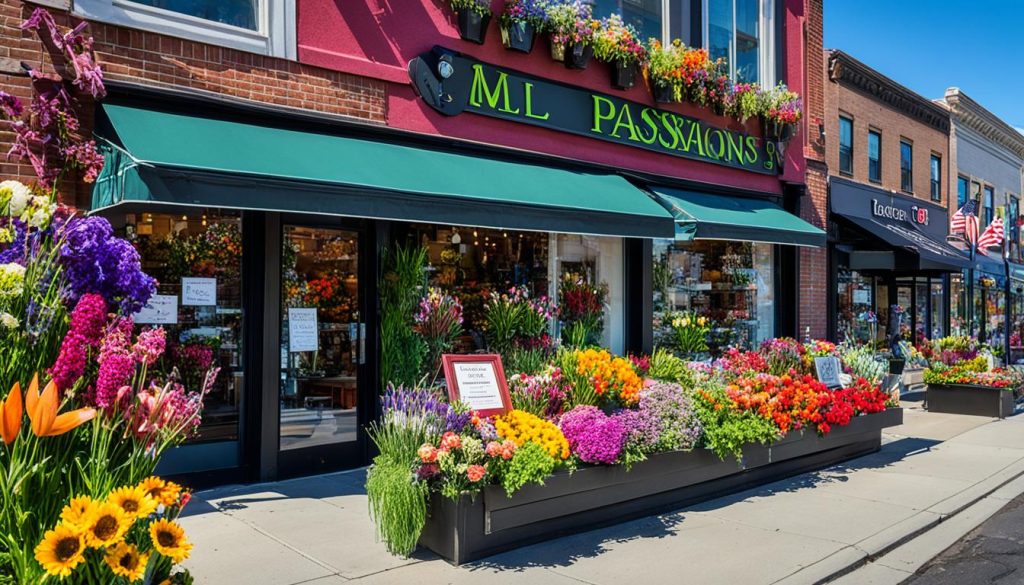Are you passionate about flowers and dreaming of starting your own florist business? Whether you have a knack for floral arrangements or want to turn your love for flowers into a profitable venture, this beginner’s guide will provide you with valuable insights and essential steps to kickstart your journey as a florist.
Starting a flower shop requires careful planning and preparation. From writing a comprehensive florist business plan to obtaining the necessary permits and licenses, there are several crucial aspects to consider before opening your doors to customers.
In this guide, we will delve into various topics such as funding options for your florist business, choosing the perfect location for your flower shop, and effective online marketing techniques to expand your reach. Additionally, we will offer practical flower arranging tips to help you create stunning floral designs that will wow your customers. So, let’s dive in and explore how you can turn your dream of running a successful florist business into a reality.
What is a Florist Business?
A florist business is a specialized enterprise that focuses on selling cut flowers and various floral products. In this fast-growing and highly profitable industry, florists play a crucial role in providing customers with beautiful arrangements and quality floral products.
Florist shops typically specialize in selling one type of flower or decorative plant, offering a wide selection of different flowers within that category. This specialization allows florists to develop expertise in arranging and caring for specific types of flowers, ensuring the highest quality and satisfaction for customers.
Types of Florist Business
There are several types of floristry businesses, each with its unique characteristics and target markets. These include:
- Flower shops – Traditional brick-and-mortar stores that cater to local customers and provide a wide range of flower arrangements and bouquets.
- Mobile florists – Businesses that operate from a mobile unit, such as a truck or trailer, allowing them to bring their floral products directly to customers at various locations or events.
- Commercial florists – Florists who primarily cater to corporate clients, providing floral arrangements for offices, hotels, restaurants, and other commercial establishments.
- Independent florists – Small-scale florists who operate independently and focus on unique and personalized floral designs for special occasions.
Florists rely on advertising and word-of-mouth marketing to attract customers. They might promote their businesses through various channels, including local directories, online directories, social media platforms, and partnerships with event planners or wedding venues.
To better understand the breadth of floral products available and find inspiration for their arrangements, florists often attend trade shows and industry events to connect with suppliers and stay updated on the latest trends. These opportunities allow florists to expand their knowledge, discover new varieties of flowers, and source high-quality products for their customers.
Whether it’s a grand wedding centerpiece or a simple bouquet to brighten someone’s day, a florist business thrives by providing customers with beautiful, thoughtfully arranged flowers that convey emotions and create memorable experiences.
How to Start a Florist Business?
Starting a florist business can be an exciting and fulfilling venture, but it also comes with its fair share of risks. To successfully launch your florist business, you need to take several crucial steps to set a strong foundation. Here are the key aspects you should consider:
1. Identify Your Florist Service
Decide on the type of florist service you want to provide. Consider whether you want to focus on retail flower sales, event floral arrangements, or both. Understanding your niche will help define your target market and develop appropriate marketing strategies.
2. Research the Market and Assess Competitors
Thoroughly research the floral industry in your area to understand customer preferences, market trends, and potential competitors. Identifying strong competitors will allow you to differentiate your business and offer unique selling propositions to attract customers.
3. Secure a Suitable Location
Choosing the right location is vital for a florist business. Look for areas with high foot traffic and access to your target market. Consider leasing or purchasing a space that offers ample room for floral arrangements and customer interactions.
4. Determine Start-up Costs and Funding Options
Starting a florist business requires financing to cover various expenses, such as inventory, equipment, marketing, and licenses. Create a detailed business plan that outlines all the costs involved and explore funding options like personal savings, loans, or grants.
5. Acquire Essential Skills and Qualifications
While formal qualifications may not be mandatory, acquiring floral arrangement skills and relevant certifications can enhance your credibility and attract customers. Consider participating in training programs or workshops to sharpen your creative and business management skills.
6. Develop a Business Plan
A well-crafted business plan is essential for steering your florist business towards success. Outline your goals, target market, financial projections, marketing strategies, and future growth plans. A comprehensive business plan will help you stay organized and make informed decisions.
7. Register, Obtain Licenses, and Permits
Ensure compliance with legal requirements by registering your business and obtaining the necessary licenses and permits. Check with local authorities to understand the specific regulations and documentation needed for operating a florist business in your area.
8. Build Relationships with Suppliers
Establish strong relationships with flower suppliers to ensure a consistent and high-quality inventory. Research wholesalers and local growers to find the best sources of fresh flowers at competitive prices. Building reliable partnerships is crucial for your long-term success.
By following these steps and diligently executing your plan, you can lay a solid foundation for a successful florist business.

| Inventory and Equipment | Estimated Cost (£) |
|---|---|
| Flower inventory | 500 – 5,000 |
| Containers and vases | 100 – 500 |
| Tools (scissors, wire cutters, etc.) | 50 – 200 |
| Refrigeration equipment | 500 – 2,000 |
| Point of sale system | 500 – 1,500 |
Skills, Training, and Qualifications for Florists
While formal qualifications or training are not necessarily required to start a florist business, having them can provide a competitive advantage and help provide quality service. As a florist, various skills are crucial for success, including flower arranging, customer service, marketing, creativity, and business management.
Flower arranging is at the core of a florist’s expertise. It involves creating beautiful and visually appealing floral arrangements using different techniques and design principles. A skilled florist can turn a simple bouquet into a stunning work of art that captures the essence of any occasion.
Providing exceptional customer service is another vital skill for florists. Building strong relationships with clients, understanding their needs, and delivering personalized experiences can enhance customer satisfaction and loyalty. Strong communication skills and the ability to suggest appropriate floral arrangements based on customers’ preferences and budgets are essential.
Marketing skills are crucial for attracting customers and promoting a florist business effectively. Knowing how to identify target markets, create compelling marketing messages, and utilize different advertising channels can help reach a wider audience and generate more sales.
Creativity is an integral part of the florist profession. Having an eye for design, color coordination, and understanding of seasonal trends can help florists create unique and captivating arrangements that stand out from the competition.
Business management skills are also necessary for running a successful florist business. These include budgeting, inventory management, supplier relationship management, and basic accounting knowledge. Being organized and efficient in these areas helps ensure smooth operations and profitability.
Training courses and workshops are available for those interested in developing their skills further. These programs offer hands-on experience, industry insights, and guidance from experienced professionals. Additionally, vocational courses and apprenticeships can provide formal qualifications in floristry, demonstrating expertise and credibility in the industry.
Obtaining relevant qualifications can not only enhance the reputation of a florist business but also instill confidence in potential customers. They serve as proof of knowledge and expertise in the field and can set a florist apart from competitors. Accredited qualifications may cover areas such as floral design, business management, and customer service.

Costs and Funding for a Florist Business
When starting a florist business, it’s important to consider the costs involved and explore funding options to support your venture. The start-up costs can vary depending on the size of the business and its specific requirements. Here are some of the key expenses to consider:
- Leasing or Purchasing a Location: The cost of renting or buying a suitable space for your flower shop is a major expense. Location is crucial, as it can impact foot traffic and visibility.
- Equipment and Supplies: To operate your florist business, you’ll need essential equipment such as floral design tools, refrigeration units, shelving, and point-of-sale systems. Additionally, you’ll need to invest in a wide range of supplies including various types of flowers, vases, ribbons, and packaging materials.
- Stock or Inventory: Building up your initial stock of flowers and accessories can incur significant costs. It’s important to carefully plan and manage your inventory to avoid waste.
- Marketing Materials: Promoting your florist business requires marketing materials such as business cards, brochures, flyers, and signage. These materials help create brand awareness and attract potential customers.
- Hiring Staff: If you plan to hire employees, you’ll need to budget for salaries and any associated costs such as training and benefits. Staffing needs will depend on the size and scope of your business.
To accurately estimate the costs of starting your florist business, it’s crucial to create a detailed business plan. A comprehensive plan will outline all your projected expenses and help identify potential funding needs. Additionally, a well-crafted business plan can be useful when approaching funding sources.
There are various funding options available to help finance your florist business:
- Personal Savings: Using your personal savings is a common way to fund a small business. By investing your own money, you retain full control over your business and avoid accruing debt.
- Loans: Banks and financial institutions offer small business loans that can provide the capital needed to start or expand your florist business. Explore different loan options and compare interest rates and repayment terms to find the most suitable option for your needs.
- Grants: In some cases, you may qualify for grants specifically designed to support small businesses in the floral industry. Research local and national grant programs to see if you meet the eligibility criteria.
- Partnerships: Collaborating with a business partner or seeking angel investors can be a way to secure additional funding. Partnerships can bring in additional expertise and resources.
Ultimately, the costs and funding requirements for your florist business will depend on various factors. Conduct thorough research, create a detailed financial plan, and explore all available funding options to ensure a successful start to your venture.
Funding Options for a Florist Business:
| Funding Option | Description |
|---|---|
| Personal Savings | Using personal funds to finance the business, providing full control and avoiding debt. |
| Loans | Borrowing capital from banks or financial institutions with set interest rates and repayment terms. |
| Grants | Obtaining financial support from local or national grant programs designed for small businesses, if eligible. |
| Partnerships | Collaborating with a business partner or securing angel investors to bring in additional funding and expertise. |

Choosing a Location and Marketing for a Florist Business
When starting a florist business, one of the most crucial decisions you’ll make is choosing the right location. The success of your business largely depends on factors such as foot traffic, competition, accessibility, and the demographics of your target market.
A prime location with high foot traffic can significantly increase your chances of attracting potential customers. Consider areas near shopping centres, residential neighbourhoods, or office buildings where people frequently pass by. A visible location with easy access and parking facilities can also make it convenient for customers to visit your flower shop.
It’s important to research the competition in the area you are considering. Look for areas with fewer existing flower shops or ones that offer different types of floral products to avoid direct competition. This will give your business a unique selling point and make it easier to stand out in the market.
In addition to choosing the right location, effective marketing strategies are essential to promote your florist business. A combination of traditional and online marketing methods can help you reach a wider audience and attract potential customers.
Traditional Marketing Tactics:
- Distribute flyers or leaflets in the local community to raise awareness about your flower shop.
- Place advertisements in local newspapers or magazines that target your desired customer base.
- Collaborate with other local businesses to cross-promote each other’s services.
- Create eye-catching signage outside your shop to attract attention from passersby.
Online Marketing Strategies:
- Establish a professional website for your florist business, showcasing your products and services.
- Utilize social media platforms such as Facebook, Instagram, and Twitter to engage with customers, share updates, and showcase your floral arrangements.
- Implement search engine optimization (SEO) techniques to improve your online visibility and attract organic traffic to your website.
- Consider partnering with online flower marketplaces or delivery platforms to expand your reach and gain access to a wider customer base.
Remember, a visually appealing and user-friendly website, engaging social media content, and effective SEO can significantly boost your online presence and attract customers who prefer to shop for flowers online.
By choosing the right location and implementing effective marketing strategies, you can increase the visibility and success of your florist business. Be consistent in delivering high-quality products, exceptional customer service, and maintaining a strong online and offline presence to build a loyal customer base.

| Choosing a Location and Marketing for a Florist Business | |
|---|---|
| Factors to consider | Foot traffic, competition, accessibility, target market demographics |
| Traditional Marketing Tactics | Flyer distribution, local advertising, partnerships with other businesses, eye-catching signage |
| Online Marketing Strategies | Professional website, social media presence, search engine optimization, online partnerships |
Conclusion
Starting a florist business can be a challenging yet rewarding venture. By acquiring the necessary skills, training, and qualifications, you can navigate the complexities of the industry and establish a successful flower shop. It is vital to meticulously plan and execute your business strategy, considering all aspects including location, marketing, and customer satisfaction.
Continuous adaptation and improvement are essential to meet the evolving needs of your customers. Providing high-quality products combined with exceptional customer service will help you build a loyal customer base and drive profitability.
With dedication and perseverance, you can transform your passion for flowers into a thriving florist business. So, take the first step and embark on this journey to make your dream of becoming a florist a reality.
FAQs
How to start a flower business from home in the UK?
Starting a flower business from home in the UK involves steps like creating a business plan, researching suppliers, setting up an online presence, obtaining necessary permits, and showcasing your unique floral arrangements to attract customers.
How much do florists get paid UK?
Florists in the UK can earn an average salary ranging from around £17,000 to £25,000 per year, depending on experience, location, and the type of floral business they work for.
Is flower business profitable in the UK?
The flower business in the UK can be profitable for those who offer quality products, exceptional customer service, and unique arrangements, with potential for success through weddings, events, subscriptions, and online sales.
Do you need a Licence to sell flowers UK?
In the UK, a license is not typically required to sell flowers unless you plan to sell protected plants or flowers harvested from the wild, in which case you may need permission.
How do I become a qualified florist UK?
To become a qualified florist in the UK, individuals can pursue formal training through floristry courses, apprenticeships, or certifications from reputable institutions to develop skills in floral design, arrangement, and business management.
Can you make a living selling flowers?
Selling flowers can be a viable way to make a living for florists who create in-demand arrangements, provide excellent customer service, manage costs effectively, and market their products strategically to attract a steady clientele.
What do florists do with unsold flowers UK?
In the UK, florists may repurpose unsold flowers by creating new arrangements, offering discounted sales, donating to local charities or hospices, composting organic waste, or participating in flower recycling programs.
Can you sell things in your front garden in the UK?
Selling items from your front garden in the UK may require planning permission or adherence to local regulations depending on the type of goods sold, frequency of sales, and impact on the neighborhood.
Is picking flowers illegal UK?
Picking certain wildflowers or protected species may be illegal in the UK under conservation laws to preserve native flora; it is advisable to check local regulations and avoid picking flowers in protected areas.
How can I sell my flowers without a shop?
Selling flowers without a shop in the UK can be done through online platforms, local markets, pop-up stalls, subscription services, event collaborations, partnerships with local businesses, and social media marketing to reach customers effectively.





